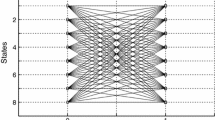Abstract
In this paper we consider the design of space-time trellis codes usingorthogonal designs. We derive a condition on the codewords to obtainthe maximum received signal energy and show that the codes based onorthogonal designs satisfy this condition.We consider in detail the design of a trellis code for two transmitantennas. The new code we develophas a higher diversity in fast fading and a higher coding gain in quasi-static fading when compared to otherexisting space-time codes. We also consider a turbo implementation ofthe new trellis code which results in very high diversity gains infast fading channels.
Similar content being viewed by others
References
S.M. Alamouti, “A Simple Transmit Diversity Technique for Wireless Communication”, IEEE J. on Select Areas in Comm., Vol. 16, pp. 1451–1458, 1998.
S. Benedetto, D. Divsalar, G. Montorsi and F. Pollara, “A Soft-input Soft-output APP Module for Iterative Decoding of Concatenated Codes”, IEEE Communication Letters, Vol. 1, pp. 22–24, 1997.
S. Benedetto and F. Pollara, “On the Design of Turbo Codes”, TDA Progress Report 42-123, November 1995.
C. Berrou and A. Glavieux, “Near Optimum Error Correcting Coding and Decoding: Turbo Codes”, IEEE Transactions on Communications, Vol. 44, pp. 1261–1271, 1996.
J.H. Conway and N.J.A. Sloane, Sphere Packings, Lattices and Groups, Springer-Verlag: New York, 1998.
G.D. Forney, “Coset Codes: Introduction and Classification”, IEEE Transactions on Information Theory, Vol. 34, pp. 1123–1151, 1988.
G. G anesan and P. Stoica, “Space-Time Block Codes: A Maximum SNR Approach”, IEEE Transactions on Information Theory, Vol. 47, pp. 1650–1656, 2001.
G. Ganesan and P. Stoica, “Space-Time Diversity Using Orthogonal and Amicable Orthogonal Designs”, Wireless Personal Communications, Vol. 18, pp. 165–178, 2001.
A.V. Geramita and J. Seberry, “Orthogonal Designs, Quadratic Forms and Hadamard Matrices”, Vol. 43 of Lecture Notes in Pure and Applied Mathematics, Marcel Dekker: New York and Basel, 1979.
J.G. Proakis, Digital Communications, McGraw-Hill: New York, 1989.
N. Seshadri and H. Jafarkhani, “Super-orthogonal Space-time Trellis Codes”, in Proceedings of ICC'02, pp. 1439–1443, 2002.
S. Siwmogsatham and M.P. Fitz, “Improved High-rate Space-time Codes via Orthogonality and Set Partitioning”, in Proceedings of WCNC'02, pp. 264–270, 2002.
V. Tarokh, H. Jafarkhani and A.R. Calderbank, “Space-Time Block Codes from Orthogonal Designs”, IEEE Trans. on Info. Theory, Vol. 45, pp. 1456–1467, 1999.
V. Tarokh, N. Seshadri and A.R. Calderbank, “Space-Time Codes for High Data Rate Wireless Communication: Performance Criterion and Code Construction”, IEEE Trans. on Info. Theory, Vol. 44, pp. 744–765, 1998.
Author information
Authors and Affiliations
Rights and permissions
About this article
Cite this article
Ganesan, G., Stoica, P. Constructing Space-Time Trellis Codes Using Orthogonal Designs. Wireless Personal Communications 28, 1–15 (2004). https://doi.org/10.1023/B:WIRE.0000015381.58062.91
Issue Date:
DOI: https://doi.org/10.1023/B:WIRE.0000015381.58062.91



